http://www.arkive.org/anglerfish/lophius-piscatorius/video-08.htmlhttp://www.bbc.co.uk/nature/blueplanet/alien/flash/main_game.shtml
The angry-looking deep sea anglerfish has a right to be cranky. It is quite possibly the ugliest animal on the planet, and it lives in what is easily Earth's most inhospitable habitat: the lonely, lightless bottom of the sea.
There are more than 200 species of anglerfish, most of which live in the murky depths of the Atlantic and Antarctic oceans, up to a mile below the surface, although some live in shallow, tropical environments. Generally dark gray to dark brown in color, they have huge heads and enormous crescent-shaped mouths filled with sharp, translucent teeth. Some angler fish can be quite large, reaching 3.3 feet (1 meter) in length. Most however are significantly smaller, often less than a foot.
Their most distinctive feature, worn only by females, is a piece of dorsal spine that protrudes above their mouths like a fishing pole—hence their name. Tipped with a lure of luminous flesh this built-in rod baits prey close enough to be snatched. Their mouths are so big and their bodies so pliable, they can actually swallow prey up to twice their own size.
The male, which is significantly smaller than the female, has no need for such an adaptation. In lieu of continually seeking the vast abyss for a female, it has evolved into a permanent parasitic mate. When a young, free-swimming male angler encounters a female, he latches onto her with his sharp teeth. Over time, the male physically fuses with the female, connecting to her skin and bloodstream and losing his eyes and all his internal organs except the testes. A female will carry six or more males on her body.
The Deep Sea Anglerfish
(Melanocetus johnsoni)
 The deep sea anglerfish is one of the most bizarre-looking fish in the sea. Known scientifically as Melanocetus johnsoni, it is also one of the best-known creatures of the deep. It is one of about 200 species of anglerfish found throughout the world's oceans. The angler gets its name from the elongated dorsal spine that supports a light-producing organ known as a photophore. Through a chemical process known as bioluminescence, this photophore can produce a blue-green light similar to that of a firefly on land. The fish uses this appendage like a fishing lure, waving it back and forth to attract its prey.
The deep sea anglerfish is one of the most bizarre-looking fish in the sea. Known scientifically as Melanocetus johnsoni, it is also one of the best-known creatures of the deep. It is one of about 200 species of anglerfish found throughout the world's oceans. The angler gets its name from the elongated dorsal spine that supports a light-producing organ known as a photophore. Through a chemical process known as bioluminescence, this photophore can produce a blue-green light similar to that of a firefly on land. The fish uses this appendage like a fishing lure, waving it back and forth to attract its prey.
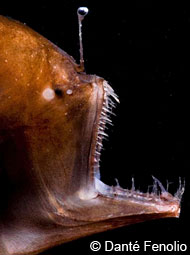
Closeup of female anglerfish
showing its large teeth & lure
(Image courtesy of Danté Fenolio)
The deep sea anglerfish has a round body that resembles a basketball, and indeed, it looks like it could easily swallow one. It has a very large mouth with sharp, fang-like teeth. Its grotesque appearance has earned it the nickname "common black devil". Despite its ferocious appearance, the angler is a small fish, reaching a maximum length of only about five inches (12 centimeters). The color of this anglerfish ranges from brown to dark gray or black. It has soft flesh and bones and small eyes. Its skin is specially adapted to reflect blue light. Since nearly all light emitted from bioluminescent creatures is blue, the anglerfish can be nearly invisible to other deep sea animals. Due to its wide, round body, it cannot swim very fast. Instead, it somewhat "wobbles" through the water.
The anglerfish uses its illuminated lure as its hunts for prey. This specialized spine is highly maneuverable and can be moved in any direction. The anglerfish is known to remain completely motionless, waving its lure back and forth like a fishing pole. When the prey fish gets close enough, the angler snaps it up with its powerful jaws and swallows it whole. The sharp teeth of the angler are angled inwards, which helps to prevent the prey from escaping. The anglerfish can extend both its jaw and its stomach to an incredible size, allowing it to swallow prey twice the size of its entire body. Since food can be scarce in the deep sea, this special adaptation allows it to stock up on food during times of plenty.
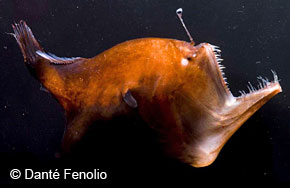
Image of a female deep sea anglerfish
(Image courtesy of Danté Fenolio)
The deep sea anglerfish has an extremely unusual method of reproduction. The male angler is much smaller than the female and completely different in appearance. It is about the size of a small finger and black in color. When a male angler matures, its digestive system degenerates, making it impossible for it to feed on its own. It must now find a female or die of starvation. The male angler has small hook teeth, which it uses to attach itself to the female. Once he bites into her skin, he releases an enzyme that dissolves the skin of his mouth and that of her body. The two become fused together and their blood vessels join as one. The male will spend the rest of its life joined to the female like a parasite, getting all of his nourishment from her body. A female can carry up to six males on her body at a time. This bizarre method of reproduction helps to ensure that when the female is ready to spawn, she has a mate instantly available. The female will lay her eggs in a thin sheet of gelatinous material two or three feet (about one meter) wide and about 30 feet (9 meters) long. This thin sheet of eggs floats free in the sea until the eggs hatch into tiny larvae. Once hatched, the larvae swim to the surface and feed on plankton. As they mature, they return to the depths below.
The deep sea angler is found throughout the world's oceans at depths of over 3,000 feet (914 meters). At this depth, there is almost no light and the water is near freezing. Many species of anglerfish are fished commercially throughout the world. They are compared to lobster in taste and texture. In Japan, anglerfish is considered a delicacy and can fetch a premium price.http://www.seasky.org/deep-sea/anglerfish.html
Habitat: The angler fish lives in the twilight zone, dark zone,and abyss
Prey: plankton, lantern fish, viper fish, hachet fish dragon fish, fangtooth
Predator:



Anglerfish range
I can tell that the angler fish is nowhere near
extinction.
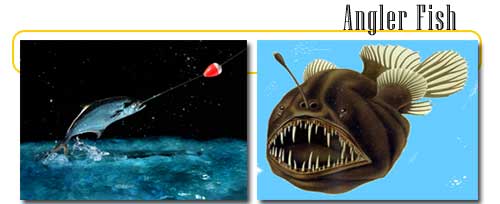 |
|
Anglerfishes are named for their characteristic method of predation, which involves the use of the modified first spine from the first or spinous dorsal fin. This spine (the illicium) protrudes above the fish's eyes, with a fleshy growth (the esca) at the tip of the spine (the netdevil anglerfish has similar growths protruding from its chin as well). This growth can be wiggled so as to resemble a prey animal, and thus to act as bait to lure other predators close enough for the anglerfish to devour them whole.
|
|
|
|

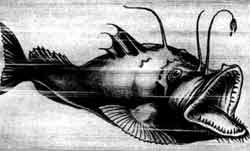 Angler Table Manners: The anglerfish is able to distend both its jaw and its stomach (its bones are thin and flexible) to enormous size, allowing it to swallow prey up to twice as large as its entire body. Angler Table Manners: The anglerfish is able to distend both its jaw and its stomach (its bones are thin and flexible) to enormous size, allowing it to swallow prey up to twice as large as its entire body.
Like Moths to a Flame: As most anglerfish live mainly in the oceans' aphotic zones, where the water is too deep for sunlight to penetrate, their predation relies on the "lure" being bioluminescent (via bacterial symbiosis). In a related adaptation, anglerfish are dull gray, dark brown or black, and are thus not visible either in their own light or in that of similarly luminescent prey.
Walking and Talking: Some benthic (bottom-dwelling) forms of anglerfish have arm-like pectoral fins which the fish use to walk along the ocean floor.
|
Deep Sea Angler Fish
For more pictures of Deep Sea Angler fish and other deep sea pictures, click here
|
Illustrated here are the larval and adult forms of deep sea angler fish. Deep sea anglers, suborder Ceratioidea, are represented by about 120 species, belonging to eleven different families. Note that the larval form (? Melanocetus sp.) is surrounded by a gelatinous epidermal layer, possibly providing protection, and has not yet developed the lure. In comparison the adult (Melaoncetus sp.) obviously displays its fishing pole lure. Both images were taken by Dr Peter Herring while on board the RS Discovery Vessel.
Deep sea anglers differ from other anglers by the absence of ventral fins. Whereas other anglers live on the bottom from shallow to deep water or, in a few cases such as the Sargassum Angler Fish (Histrio histrio), at the surface, the deep sea ceratioid anglers are mostly midwater forms, ranging in depth from from perhaps one thousand to several thousand feet. Only the females have fishing poles. Since in the depths it would be difficult to see the lure, the tip is usually equipped with a light-producing organ of some kind. It is not known for certain how this light is produced; one suggestion is that luminescent bacteria are responsible.
|
http://www.imagequest3d.com/pages/current/pictureoftheweek/deepseaangler/anglerfish.htm
Deep sea anglerfishes, habitat and range
Eleven families of the order Lophiiformes (anglerfishes) live in the deep sea, with nearly a hundred species, more than any other group of bathypelagic fishes.
Suborder of Ogcocephalioidei: Caulophrynidae (Fanfins), Centrophrynidae (deep-sea anglerfishes), Ceratiidae (Seadevils), Diceratiidae (Double anglers), Gigantactinidae (Whipnose anglers), Himantolophidae (Footballfishes), Linophrynidae (Leftvents), Melanocetidae (Black seadevils), Neoceratiidae (Toothed seadevils), Oneirodidae (Dreamers) and Thaumatichthyidae (Wolftrap anglers).
There are two more families of anglerfishes which live in deep waters, Chaunacidae (Sea toads) and Lophiidae (Goosefishes). A third family, Ogcocephalidae (Batfishes) lives mostly in shallow water but can also be found in deep water. In contrast species of the family Antennariidae (frogfishes) live mostly in shallow water, close to coral reefs.
Please look at the taxonomic classification of Lophiiformes (anglerfishes)

Appearance
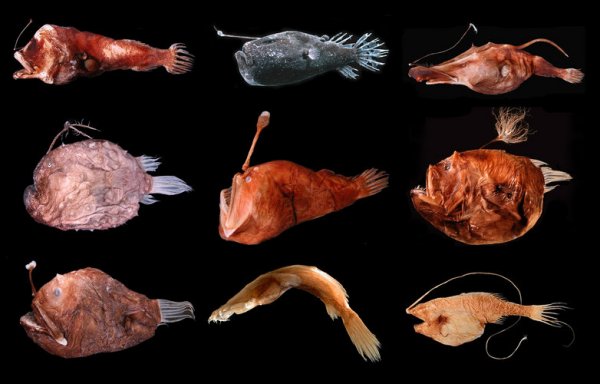
Theodore W. Pietsch and Christopher P. Kenaley ( click here for a larger image)
Female deep sea anglerfishes have a globular shape, not adapted for sustained rapid swimming, but designed for remaining motionless much of the time. Only Gigantactinidae (whipnose anglers) have an elongate form that is suitable for brief bursts of swimming. Unlike the colorful frogfishes that live in coral reefs, deep-sea anglerfish skin is grimy black or gray and fragile, without scales. In fact, their skin is so thin it can slip off their bodies when touched by human hands retrieving them from deep-ocean nets! They have flabby muscles and weak skeletons. Gill slits are very small, C-shaped and placed below the pectorals and a little behind them.
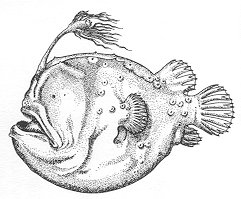
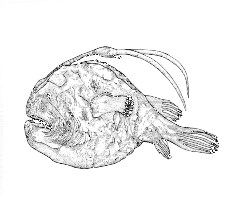
Himantolophidae (Footballfishes) with a globular shape ideal for hovering motionless. Himantolophus groenlandicus (left) has a whip shaped lure, Himantolophus mauli (right) has a forked lure.
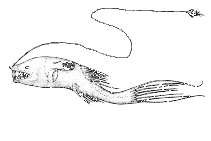
Gigantactis macronema (Family Gigantactinidae or Whipnose anglers) with a more elongate body and a long whip-like lure attached to the tip of the snout. In some cases the lure can be four or five times longer than the fish itself.
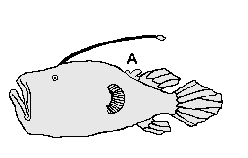
Cryptopasaras couesi (triplewart sea devil) belongs to the family of Ceratiidae. The female has three luminescent sacs, called caruncles (A), in front of her dorsal fin. These are a pair of low, fleshy appendages and have been interpreted as vestiges of the first dorsal fin, for each of them encloses a spine that can be felt if not seen. Their exact function is not known, presumably they also aid in enticing prey to within striking distance.
The female seadevils are the largest deepsea anglerfishes, reaching up to one and a half meters and then weighting around 10 kg, compared with them the males are dwarfs, weighting only about 150 grams.
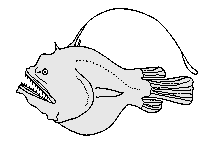
Bufoceratias wedli of the family Diceratiidae (Double anglers) with two lures visible on the back, a smaller behind the larger one
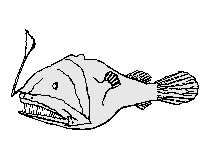
Chaenophryne melanorhabdus of the family Oneirodidae (Dreamers) with its illicium (lure) which is sharply bent and can be positioned directly in front of the mouth.

Lasiognathus saccostoma of the family Thaumatichthyidae (Wolftrap anglers) with a large overbite with huge movable teeth and a lure with three bony hooks
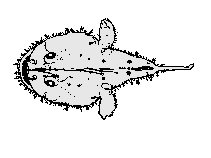
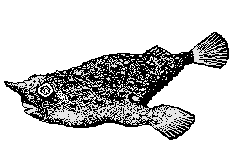
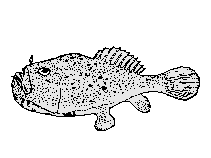
Lophiidae (Goosefishes) - Ogcocephalidae (Batfishes) - Chaunacidae (Sea toads)
These anglerfishes that live on the bottom (benthic) still have fins that look like legs, similar to the frogfishes. Look at this website for more information about batfishes.

Luring with bioluminescence
In open water food is much more reliably available than in the deep ocean where meals are rare and unpredictable. Animals livingin the seed sea have developed strategies to find food and ways to eat whatever food there may be with as little effort as possible. In deeper waters of the ocean there are a lot of animals, which prefer to await for the arrival of prey or food particles rather than to search them out actively. Many animals are not very selective in their diet and they can cope with amazing large prey.
Female anglerfishes are classic lurk-and-lure predators. They have a large mouth and their teeth are huge compared to their body size. Instead of searching actively for prey, they wave a luminous lure to attract them. They can cope with very large prey, because their expandable jaws open double wide and they posses an elastic stomach and they eat any prey available. But their most amazing feature is a bioluminescent lure.
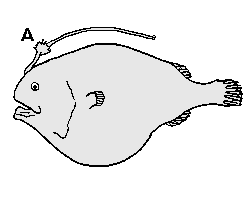
Phyllorhinichthys micractis (Oneirodidae - Dreamers) with lure and esca which has hair shaped appendices and a long pipe with a lens at the tip. There is a bulb like light organ (A) containing a gland with luminous bacteria.
The lures of the female deep sea anglerfish (male anglerfish have no luminous organs) is much more elaborate than the lure of the shallow water species and in addition bioluminescence is used to attract the prey in the dark. The lures are modified dorsal fins and contain luminous bacteria which produce a bluish, greenish light. The light and movement of the lure attract the prey to within reach of the gaping jaws. The anglerfish Cryptopsaras can slide the rod part of the apparatus back into a groove, drawing the lure and prey closer to the mouth. It can rotate the lure tip and produce a flash from it as well as a glow. All this is controlled by enzymes and the contraction of chromatophores.
The lures of deep sea anglerfishes are extraordinary elaborate, with sensory filaments, papillae, light pipes and shutters. It may be, that different species mimic different kinds of small prey like shrimps to attract larger prey. One anglerfish (Caulophryne) has a lure ornamented with many filaments but it is not luminous. An other (Linophryne) has not only a luminous lure on the head but also a multibranched barbel hanging from the lower jay. The barbel filaments contain many more bioluminescent organs.
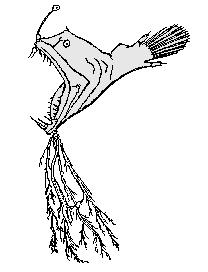
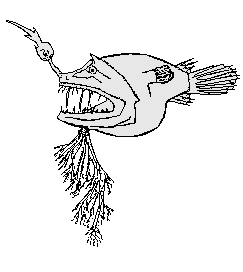
Linophrynidae (Leftvents) with lure and barbels. The Latin name literally means "toad that fishes with a net". Linophryne algibarbata (left) and Linophryne arborifera (right).

Some deep sea anglerfish have positioned their lure inside the mouth. The wolftrapangler Thaumatichthys axeli is a sit-and-wait ambush predator with a luminescent lure hanging from the roof of his overshot mouth, which is fringed with hooked sharp teeth. This anglerfish hovers just above the substrate (not sitting on it).

Other sense organs
Some deep sea anglerfishes have so called neuromast structures or organs formed by groups of hair cells. The structures look like antennae or thick hair and sit on the trunk or are mounted on long stalks or fin rays. With these freestanding structures they can sense the "noise" engendered by a fish's movement. While floating neutrally buoyant in the water, the anglerfish can probably sense the direction and the velocity of approaching prey.
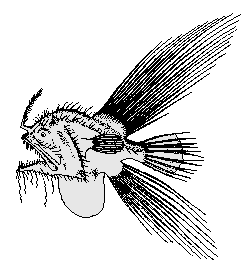
Caulophryne polynema of the family Caulophrynidae (Fanfins) relies solely on its superficial sensory neuromast structures to find prey and doesn't have a luminous lure. It also has soft skin and a highly expandable stomach.
Photos
I can't offer you any of my own photos, since I have never seen a live deep sea anglerfish. My photos are about frogfishes living on coral reefs. Please check out the following pages:
Fishbase has the largest collection of photos of deep sea anglerfishes - look at the taxonomy page and click on the link next to the species names.
The Australian Museum has a website with several photos and a good description and some close-ups of the lure, esca and caruncles. Search by Latin name.
NOVA has a page about deepsea anglerfishes with some nice photos of living anglerfishes taken underwater.
Google image search works quite well, if you search for the Latin names.
The Worsley school has a page with photos of living deep sea anglers
Some really interesting black-and-white photos and illustrations I have found on Tierlexikon, a German page. Even if you don't understand the text, just hover with your cursor over the text that says "(Abbildung ...)" and a small photo is visible. Then click on the underlined word to see a larger photo http://www.frogfish.ch/deepsea-anglerfish.html
Comments (11)
June Shanahan said
at 8:11 pm on Apr 21, 2009
I truly hope I never see an angler fish up close. Seeing a photo is scary enough to last a lifetime!
June Shanahan said
at 9:13 pm on Apr 22, 2009
I was smiling from ear to ear when I clicked on that link about LEGOS! I can't believe you found that link!
June Shanahan said
at 7:48 am on Apr 24, 2009
Cite your sources, Dude.
Fabian said
at 10:36 am on May 4, 2009
DUDE! It is awsome! whooo.
Nicole said
at 7:11 pm on May 5, 2009
Awsome! :)
Chris said
at 5:22 pm on May 7, 2009
I like the adult form of the angler fish.
Aaron Gondensen said
at 9:56 am on May 13, 2009
What's an angler fish?
Samantha said
at 10:40 am on May 13, 2009
Those are so cool I love there light. like finding nemo angler fish.
Fabian said
at 10:45 am on May 13, 2009
DUDE! It is awsome! whooo and it will die to a viperfish!
June Shanahan said
at 4:13 am on May 19, 2009
Your presentation at the Smart Board was outstanding, and your angler fish video will haunt me for all the days of my life. If you tried to scare us all silly, it worked!!!!! I am never going scuba diving again because of your research project. :-)
100%
A+
Excellent!
Emily said
at 10:41 am on May 26, 2009
Anthony your creature is kind of scary, but it is cool at the sametime!
You don't have permission to comment on this page.